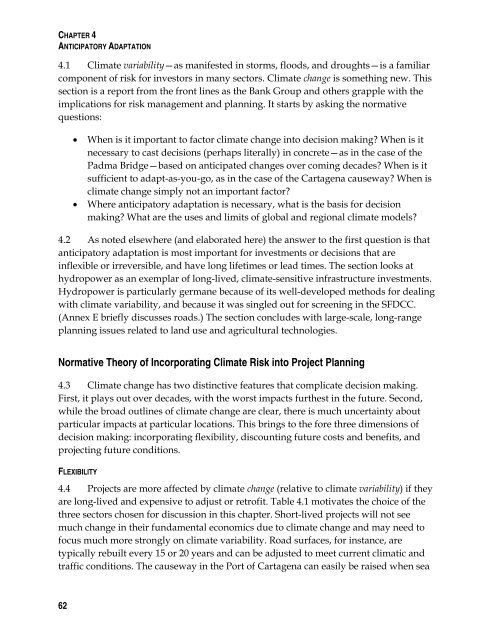Adapting to Climate Change: Assessing the World Bank Group ...
Adapting to Climate Change: Assessing the World Bank Group ...
Adapting to Climate Change: Assessing the World Bank Group ...
You also want an ePaper? Increase the reach of your titles
YUMPU automatically turns print PDFs into web optimized ePapers that Google loves.
CHAPTER 4ANTICIPATORY ADAPTATION4.1 <strong>Climate</strong> variability—as manifested in s<strong>to</strong>rms, floods, and droughts—is a familiarcomponent of risk for inves<strong>to</strong>rs in many sec<strong>to</strong>rs. <strong>Climate</strong> change is something new. Thissection is a report from <strong>the</strong> front lines as <strong>the</strong> <strong>Bank</strong> <strong>Group</strong> and o<strong>the</strong>rs grapple with <strong>the</strong>implications for risk management and planning. It starts by asking <strong>the</strong> normativequestions:When is it important <strong>to</strong> fac<strong>to</strong>r climate change in<strong>to</strong> decision making? When is itnecessary <strong>to</strong> cast decisions (perhaps literally) in concrete—as in <strong>the</strong> case of <strong>the</strong>Padma Bridge—based on anticipated changes over coming decades? When is itsufficient <strong>to</strong> adapt-as-you-go, as in <strong>the</strong> case of <strong>the</strong> Cartagena causeway? When isclimate change simply not an important fac<strong>to</strong>r?Where anticipa<strong>to</strong>ry adaptation is necessary, what is <strong>the</strong> basis for decisionmaking? What are <strong>the</strong> uses and limits of global and regional climate models?4.2 As noted elsewhere (and elaborated here) <strong>the</strong> answer <strong>to</strong> <strong>the</strong> first question is thatanticipa<strong>to</strong>ry adaptation is most important for investments or decisions that areinflexible or irreversible, and have long lifetimes or lead times. The section looks athydropower as an exemplar of long-lived, climate-sensitive infrastructure investments.Hydropower is particularly germane because of its well-developed methods for dealingwith climate variability, and because it was singled out for screening in <strong>the</strong> SFDCC.(Annex E briefly discusses roads.) The section concludes with large-scale, long-rangeplanning issues related <strong>to</strong> land use and agricultural technologies.Normative Theory of Incorporating <strong>Climate</strong> Risk in<strong>to</strong> Project Planning4.3 <strong>Climate</strong> change has two distinctive features that complicate decision making.First, it plays out over decades, with <strong>the</strong> worst impacts fur<strong>the</strong>st in <strong>the</strong> future. Second,while <strong>the</strong> broad outlines of climate change are clear, <strong>the</strong>re is much uncertainty aboutparticular impacts at particular locations. This brings <strong>to</strong> <strong>the</strong> fore three dimensions ofdecision making: incorporating flexibility, discounting future costs and benefits, andprojecting future conditions.FLEXIBILITY4.4 Projects are more affected by climate change (relative <strong>to</strong> climate variability) if <strong>the</strong>yare long-lived and expensive <strong>to</strong> adjust or retrofit. Table 4.1 motivates <strong>the</strong> choice of <strong>the</strong>three sec<strong>to</strong>rs chosen for discussion in this chapter. Short-lived projects will not seemuch change in <strong>the</strong>ir fundamental economics due <strong>to</strong> climate change and may need <strong>to</strong>focus much more strongly on climate variability. Road surfaces, for instance, aretypically rebuilt every 15 or 20 years and can be adjusted <strong>to</strong> meet current climatic andtraffic conditions. The causeway in <strong>the</strong> Port of Cartagena can easily be raised when sea62

















